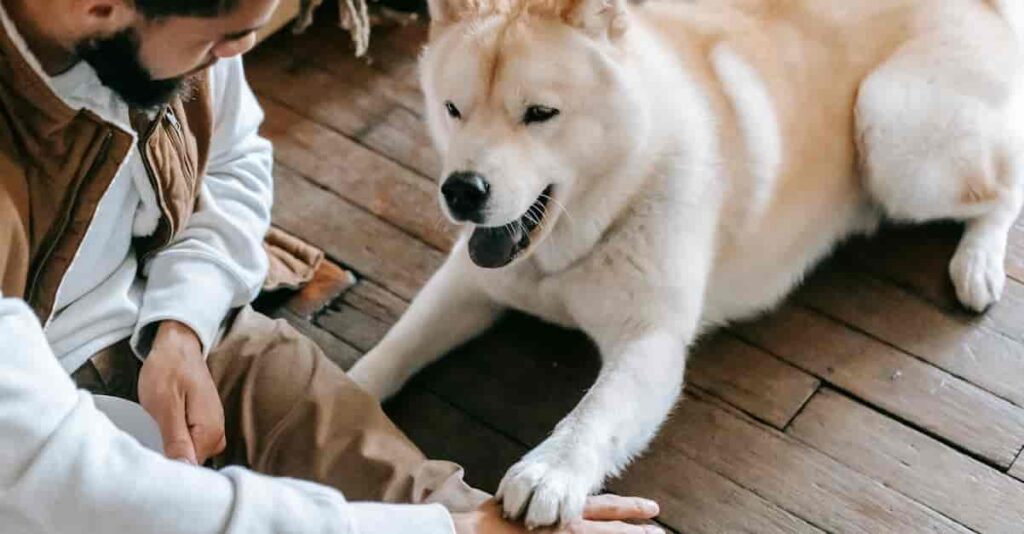House training a senior dog can be a challenging task, but it’s an important one for both the dog’s and owner’s comfort and happiness. As dogs age, they may develop issues with bladder control or have difficulty remembering their previous house training. However, with patience, consistency, and the right approach, you can successfully house train your senior furry friend.
Challenges of house training an older dog include their set habits, potential medical issues, and sometimes a resistance to change. However, senior dogs are often calmer and more eager to please than younger pups, which can make the process easier in some ways.
Preparing for House Training
Before starting the house training process, it’s crucial to establish a routine for your senior dog. Dogs thrive on consistency, so having set times for meals, potty breaks, and exercise will help them understand what is expected of them.
Sponsored Ads
Next, choose the right training method that suits your dog’s needs and living situation. The three main options are:
- Crate training: This involves confining your dog to a crate when unsupervised to prevent accidents. Crates should only be used for short periods, and your dog should be taken out regularly for potty breaks.
- Paper training: This method involves teaching your dog to eliminate on pee pads or newspapers placed in designated areas of your home. It’s useful for dogs with limited mobility or for apartment living.
- Litter box training: Similar to paper training, but using a litter box instead of pee pads. This can be a good option for small dogs or those with mobility issues.
Gather the necessary supplies for your chosen method, such as a crate, pee pads, enzymatic cleaners (to remove odors from accidents), and plenty of treats for rewarding good behavior.
Sponsored Ads
House Training Steps
- Establishing a Potty Schedule: Set a consistent schedule for taking your senior dog out to potty. A general rule is to take them out first thing in the morning, after meals, after playtime, and before bedtime. Senior dogs may need more frequent potty breaks.
- Recognizing the Signs: Learn to recognize the signs that your dog needs to go potty, such as circling, sniffing, or standing near the door. With older dogs, the signs may be more subtle, so pay close attention.
- Rewarding Good Behavior: Whenever your dog eliminates in the appropriate place, immediately reward them with treats and praise. This positive reinforcement will help them associate going potty in the right spot with something pleasant.
- Dealing with Accidents: If you catch your dog in the act of having an accident indoors, make a startling noise to interrupt them, then immediately take them outside to their potty area. Never punish your dog after the fact, as they won’t understand why they’re being scolded. Clean up accidents with an enzymatic cleaner to remove odors that could attract them to the same spot again.
Common Issues
- Medical Conditions: If your senior dog is having frequent accidents, it’s important to rule out any underlying medical conditions, such as urinary tract infections, incontinence, or age-related cognitive changes. Consult your veterinarian for proper diagnosis and treatment.
- Anxiety and Stress: Changes in environment or routine can cause anxiety and stress in older dogs, leading to house training setbacks. Try to minimize stress and provide a calm, consistent environment during the training process.
- Confusion or Lack of Understanding: Senior dogs may have a harder time understanding what is expected of them due to cognitive decline. Be patient, use positive reinforcement consistently, and consider seeking professional help from a trainer experienced with older dogs.
Tips and Tricks
- Using Potty Commands: Establish a clear potty command, like “go potty” or “get busy,” and use it consistently when taking your senior dog to their designated potty area. This will help them associate the command with the desired behavior.
- Introducing Potty Spots: If you plan to have your dog eliminate in a specific area of your yard or on walks, introduce them to that spot by taking them there frequently and rewarding them when they go potty there.
- Gradually Increasing Freedom: Start by closely supervising your senior dog or keeping them confined to a small area. As they become more reliable, gradually increase their freedom in the house, but continue to take them out regularly.
- Seeking Professional Help: If you’re struggling with house training despite your best efforts, consider seeking help from a professional dog trainer, especially one experienced with senior dogs or house-training challenges.
Patience and Consistency
- Importance of Patience with Senior Dogs: House training a senior dog can be a slow process, as they may have developed long-standing habits or have physical or cognitive limitations. It’s crucial to be patient and understand that setbacks may occur.
- Maintaining Consistency Throughout the Process: Consistency is key when house training any dog, but it’s especially important for seniors who may struggle with change. Stick to the same routine, use the same commands, and provide the same positive reinforcement each time they succeed.
By being patient, consistent, and using positive reinforcement techniques, you can successfully house train your senior dog, allowing both of you to enjoy a comfortable, accident-free home life together.

